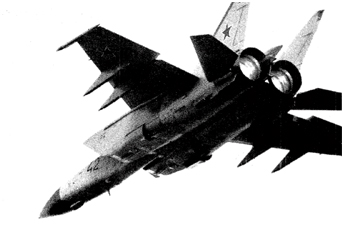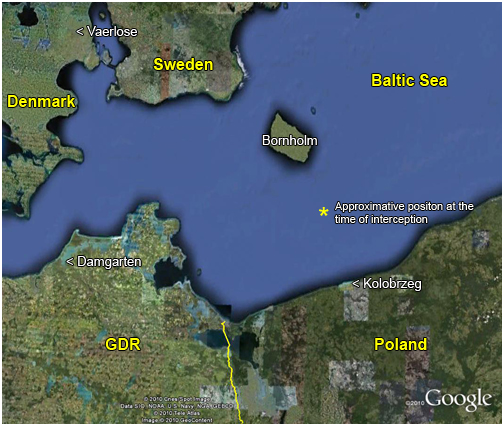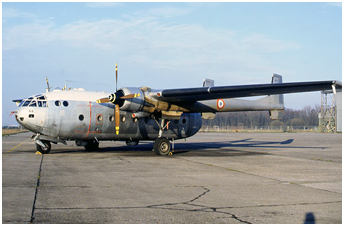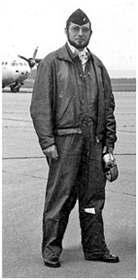Foxbat versus Noratlas ?
 A minute later, the operator in front of me gestured urgently for the analyst to come over; perhaps "Ivanovich"
said something interesting? The linguist looked very agitated and the analyst reported immediately to the team leader.
After a long parley between them, the analyst returned to his place. I asked him:
A minute later, the operator in front of me gestured urgently for the analyst to come over; perhaps "Ivanovich"
said something interesting? The linguist looked very agitated and the analyst reported immediately to the team leader.
After a long parley between them, the analyst returned to his place. I asked him:
- « What's going on? »
- « Two MiGs at 10 nautical miles took us as target! »
- « And what do we do? »
- « Nothing! »
Right or wrong, I cast an eye on my parachute in front of me and under the gaze of my hilarious neighbor put on my harness...
- « Are you afraid? »
- « You know the evacuation procedures? I am the first who has to jump! So I set the
example! »
- « You’ve at least got your bathing suit on? »
With the sea below, all this was hardly encouraging. I sat down quickly again, because the aircraft initiated a sharp turn to take up
the opposite course to the west. I was not paying so much attention to my beacons now! In addition, strong turbulence occurred, the weather
being not really good at this flight level, and the pilot decided to descend rapidly. The MiG-25 "Foxbat" that intercepted us made two passes
before heading back towards East Germany
(1).
Diversion to Vikings homeland
 A few minutes later, the captain who was the team leader of the "back-enders" returned from the cockpit and came to talk to all the operators:
« The left engine is losing rpm and the problem is getting worse; we are diverting to Copenhagen Vaerlose! » Really, this mission was far
from being monotonous. Noratlas n°42 landed finally at Vaerlose late in the afternoon. The captain was looking for a volunteer to stay inside
the plane because of the "secret défense" material aboard. Everyone ended up in a room at the airport. One thing was certain: we were not ready
to be back to Metz.
The only one to grumble aloud about the situation was the mechanic who, in the freezing cold, began to repair the left engine.
Four spark plugs had to be replaced and, as there are two spark plugs per cylinder, 2 cylinders of the 14 were faulty. Every 15 minutes,
the mechanic, no longer able to feel his fingers, came to join us in order to warm them up. Some of us would indeed lend him a hand. Meanwhile,
the captain went to file a flight plan with the team leader. Upon his return, he gave us this incredible news: the runway had been
closed since 1700 hours!
There were no more landings because of the weather and, consequently, no more takeoffs either! Nobody was laughing now. We had to secure
the sensitive documents inside the airplane rather than walk around with them, lock the doors and make contact with the French Consulate.
During these electronic warfare missions, we carried no papers and little money. Thus, the owner of a requisitioned hotel in
Copenhagen was quite glad to see 14 "Frenchies" in flight suits land. Our captain's instructions were: « Do not go out alone in town;
there must be a minimum of three of you». Later, wanting to enter a dance bar, a small problem arose - our outfits! We were in civilian clothes,
but everybody was wearing the same flying jacket. This raised the suspicion of the doorman... Then, in perfect English, we explained it all:
« French Air Force, etc. etc. » It was OK, but he asked that we leave our jackets at the entrance. Here, we decided by mutual agreement that
this no longer was viable and we left. In front of a souvenir shop window, I saw the most famous Dane in the world, the Little Mermaid of
Copenhagen... I would leave with her.
A few minutes later, the captain who was the team leader of the "back-enders" returned from the cockpit and came to talk to all the operators:
« The left engine is losing rpm and the problem is getting worse; we are diverting to Copenhagen Vaerlose! » Really, this mission was far
from being monotonous. Noratlas n°42 landed finally at Vaerlose late in the afternoon. The captain was looking for a volunteer to stay inside
the plane because of the "secret défense" material aboard. Everyone ended up in a room at the airport. One thing was certain: we were not ready
to be back to Metz.
The only one to grumble aloud about the situation was the mechanic who, in the freezing cold, began to repair the left engine.
Four spark plugs had to be replaced and, as there are two spark plugs per cylinder, 2 cylinders of the 14 were faulty. Every 15 minutes,
the mechanic, no longer able to feel his fingers, came to join us in order to warm them up. Some of us would indeed lend him a hand. Meanwhile,
the captain went to file a flight plan with the team leader. Upon his return, he gave us this incredible news: the runway had been
closed since 1700 hours!
There were no more landings because of the weather and, consequently, no more takeoffs either! Nobody was laughing now. We had to secure
the sensitive documents inside the airplane rather than walk around with them, lock the doors and make contact with the French Consulate.
During these electronic warfare missions, we carried no papers and little money. Thus, the owner of a requisitioned hotel in
Copenhagen was quite glad to see 14 "Frenchies" in flight suits land. Our captain's instructions were: « Do not go out alone in town;
there must be a minimum of three of you». Later, wanting to enter a dance bar, a small problem arose - our outfits! We were in civilian clothes,
but everybody was wearing the same flying jacket. This raised the suspicion of the doorman... Then, in perfect English, we explained it all:
« French Air Force, etc. etc. » It was OK, but he asked that we leave our jackets at the entrance. Here, we decided by mutual agreement that
this no longer was viable and we left. In front of a souvenir shop window, I saw the most famous Dane in the world, the Little Mermaid of
Copenhagen... I would leave with her.
It was December 23, 1981 at 1000 hours. Back at the airport, we expected that the glycol
(2) shower on the Noratlas was completed. It started snowing very hard; the ceiling was low,
as was the visibility... This was not a good sign. The two Bristol Hercules engines started without difficulty; engine tests were run on the taxiway,
but they were taking a long time and discussions were underway in the cockpit. In the meantime, this turned out to be a big snow storm and the
operators seemed to lack absolute confidence! The Nord accelerated on a poorly cleared runway; it was hard to keep it straight and speed increased
too slowly. My sweaty hands clung to the table, and I expected the worst! Suddenly, the engines stopped... In fact, they were idling, followed by
strong reverse. An aborted takeoff!
Three minutes later, we found ourselves at the same place on a tarmac where we really did not feel welcome... Since there was no weather improvement
in sight, we returned to the hotel. The Danish food still was unappetizing and the same security measures continued for the rest of the day.
Someone made a suggestion: « We could wait until spring!... »
December 24, 1981 arrived. I was not the only one to wake up early after an agitated sleep; I had a bad night because of the cold. It was still
dark outside; the sun rises later here at this time of year. At breakfast, the mood was gloomy. To relax the atmosphere, the captain announced
that the weather should be OK this morning. In that case, we would take off as soon as possible. With the dawning day, freezing cold greeted us
at the airbase. The temperature was -13° C, but there were no clouds in sight. The aircraft underwent a second glycol shower and what a shower
it was! It seemed as if the Danes wanted to ensure that we didn’t stay. We took possession of the aircraft one hour later, and it was like a real
deep freezer. However, still no fire extinguisher at startup; the engines started successfully, because we had previously turned the propellers by hand!
Heading South

 L'auteur, JM Sirougnet devant un Noratlas de l'EE 54.
L'auteur, JM Sirougnet devant un Noratlas de l'EE 54.
The author, JM Sirougnet in front of a Noratlas of the EE 54.
The tired captain handed over the controls to the co-pilot in the right seat, one of best in the squadron. Still, the runway was not looking good.
The checklist was completed, alignment, full throttle, brake release and we were gone. Before the departure, the Russian linguist told me: « he will
spare no effort to rip it off the ground, you'll see... ». But, we were still on the runway and there was not much remaining in front of us. Actually,
I already saw myself in the clover, ready to evacuate via any hole...
Suddenly, I did not feel any more shocks; this time, we were airborne and I saw the main landing gear retracting. Then, the two Bristol Hercules engines
were cut back to 2500 rpm, and everything was fine. We were heading south. There was no activity on "the other side"; as I watched the beacons of the main
airfields, the team leader started to write his report. It was a just past 1400 hours and we were approaching Metz. The receivers had been turned off for
some time now. The co-pilot finally performed a gentle landing; the "Baltic" mission was over for Noratlas n°42.
Epilogue
Our arrival in the hallways of the unit aroused curiosity and we heard comments like: « So, the tourists! Did you have a good time in Copenhagen? ». At the risk of being taken for a comedian, no one replied! It was at the mess, alone in the dining room, that we really completed this mission at the end of the meal, with champagne for pilot n°2. Without him, we would still be there... A few days later, the commander of FaTac - 1ère RA (3) summoned the captain and the team chief for explanations. It appears that the meeting was somewhat stormy, with the general having a hard time admitting that this mission turned into a walk in Copenhagen just because of four spark plugs... This all took place 29 years ago. Today, the Little Mermaid is in my display case and I always pause and remember when I look at her...
© JM Sirougnet
notes
(1)
The interception by MiG-25 while possible, remains uncertain. The Noratlas stood at 25-30 nautical miles SSE of the Danish island
of Bornholm, off the Polish coast when it was joined by Soviet fighters. Logically, the intruder should have been intercepted by
the alert patrol of the 773.IAP (MiG-21bis) at Damgarten or the alert partrol of the 871.IAP (MiG-23M) at Kolobrzeg in Poland, which was closer.
The MiG-25PD of 787.IAP - the only fighter variant of the "Foxbat" based in Eastern Europe - would have arrived at Finow in 1981. HM.
The picture of the MiG-25PD bort 42 that illustrates this article was one of the first series of photographs of this type of aircraft taken by Dick Genaille,
a USMLM tour officer and former Lockheed C-141 Starlifter pilot, in July 1982. Finow was a sensitive area at the time (the "Foxbat-E" had only been there a few months)
and the USMLM reconnaissance tour team took up an observation point near an approach beacon in the early morning after shaking off Stasi trackers. The reconnaissance
tour team waited for the start of air operations, took the first pictures and left the scene, waving at the Stasi narks when they crossed their path again. HM.
(2)
Deicing product.
(3)
Force Aérienne Tactique - 1ère Région Aérienne (Tactical Air Force - First Air Region).
 |
Mission 5489 < Part 1 |
 |
Plan du site - Sitemap |  |
